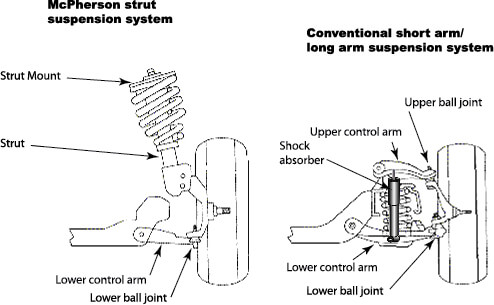What is a strut on a car?
Learn what a strut does on your car and how it’s different than a shock
When it comes to your car’s suspension system, two components always seem to cause confusion: struts and shock absorbers. While both play crucial roles in providing a smooth ride and maintaining vehicle control, they are distinct parts with different functions and designs. This article will delve into what a strut is, how it works, and how it differs from a shock absorber.
The role of a shock absorber
A shock absorber, also known as a damper, is a crucial component in a vehicle’s suspension system. Its primary function is to keep your tires on the road after hitting a bump or pothole. That sounds easy enough, but we’re talking physics here, where every action has an equal and opposite reaction. To fully understand why shock absorbers are so important, let’s walk through what happens when your tire hits a bump in the road:
• The tire hits a bump. The bump causes the tire to deflect and compress the air in the tire
• Immediately after the bump event, the compressed air inside the tire rebound, pushing the tire up
• The force and weight of the rising tire cause the vehicle’s coil, leaf, or torsion spring to compress.
• After the tire reaches the peak of its travel, the compressed spring pushes it back down, causing the tire to slam back into the pavement.
• The slamming force compresses the tire, causing it to rebound upward again.
Without a shock absorber, the compression/rebound action repeats with decreasing frequency until all the energy from the first bump is fully depleted. While that energy depletion is happening, the tire is spending a portion of the time in the air, resulting in a loss of vehicle control.
A shock absorber slows the spring’s compression and rebound rate, converting that energy into heat inside the shock.
Shocks and struts both dampen spring oscillations and rebound
Because they do the same job, shocks and struts are similar internally. But externally, they are different. In technical terms, a strut is a structural component of the suspension. You can drive a car without a shock (it’ll be a bumpy ride), but you can’t drive a vehicle without a strut (if it’s designed for struts).It allows carmakers to eliminate the upper control arm and ball joint.
Compare a traditional control arm suspension to a strut suspension
Traditional control arm automotive suspension systems incorporate a coil spring, shock absorber, and an upper and lower control arm, each fitted with bushings and a ball joint to allow the up and down and turning movements. The coil spring supports the vehicle’s weight, and the shock absorber’s only job is to dampen spring oscillations. Control arms and ball joints add weight and cost to the vehicle.

Compare struts and shocks
Struts, however, have exterior features that allow them to act as structural components. They incorporate a coil spring retaining plate located near the bottom of the strut tube, and the top of the strut piston rod is threaded.
Since struts “bridge” the gap between the top of the steering knuckle and the body of the vehicle, they allow automotive engineers to eliminate the upper control arm, bushings and upper ball joint.
Struts change your vehicle’s ride characteristics
Traditional suspension systems offer a softer ride than a strut system, but the body rolls more in turns. Strut suspension systems reduce body roll and provide a stiffer ride, which many drivers like.
The advantages of struts over shocks
They have a longer life than shocks. Depending on how you drive your vehicle, they usually last between 80,000 miles and 100,000 miles before replacement. Shocks have much shorter life around 50,000 miles.
They weigh less than a control arm suspension, saving fuel. They cost less because they eliminate the upper control arm, bushings and the upper ball joint. Eliminating the upper ball joint (a wear item) reduces ownership costs.
They provide a stiffer and more responsive ride with less body roll, providing a sportier feel.
The disadvantages of struts
Their stiffer ride is uncomfortable for some people.
They’re significantly more expensive to replace than shocks. However, the higher maintenance costs are somewhat offset by their longer life and the elimination of upper control arm bushing and ball joint replacement.
More information on shocks and struts
• Worn shock absorbers and struts can increase your stopping distance by up to 10 feet. At higher speeds, the increased stopping distance can mean the difference between a safe stop and a fatal accident.
• Worn shock absorbers and struts cause forward weight transfer and nose dive during hard braking, causing longer stopping distances and more rapid front brake wear.
• Worn shocks and struts allow tires to bounce more on bumpy roads, reducing your ability to keep the vehicle in its own lane on curves.
• Worn shocks cause tire cupping, which wears your tires out much faster and causes vibration.
To learn more about when to replace shocks and struts, read this post
To learn more about how to test shocks and struts, read this post
To learn more about strut replacement cost, read this post
©, 2017 Rick Muscoplat
Posted on by Rick Muscoplat